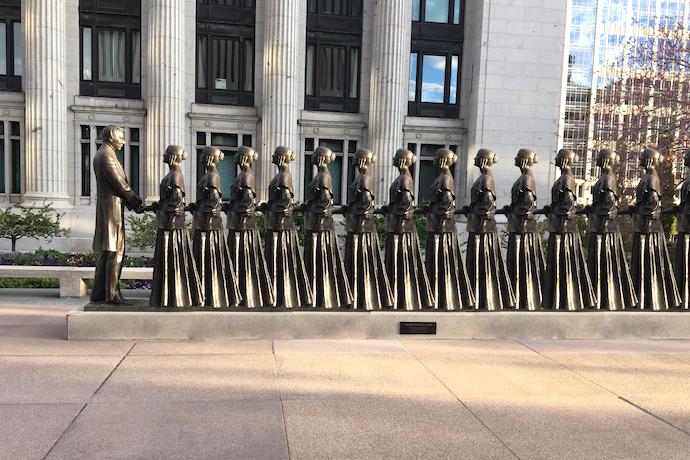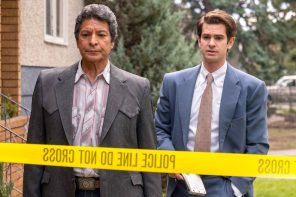This week, new legislation goes into effect in Utah that decriminalizes polygamy among consenting adults. The development, which was voted on in February, was a long-time coming. But while many decriminalization bills have been proposed over the years—Utah’s polygamy laws are the harshest in the entire country—what made this one successful was not who was involved, but who stood quietly to the side: The Church of Jesus Christ of Latter-day Saints.
The LDS Church remains a dominant force in the state, and until recently worked hard to cease any attempts to soften the state’s polygamy laws. This time, however, their silence was deafening, and it allowed the bill to pass.
Mormonism has always been inseparably connected to these policies. Utah was granted statehood in 1896, only after LDS leaders promised to give up the faith’s controversial, yet defining, feature. And though the church took more than another decade to fully divorce itself from the practice, for much of the twentieth century Mormon leaders and politicians alike were unfailing in their quest to purge the state of polygamists, adopting, as noted above, America’s most strident anti-polygamy policies.
Part of that drive was due to the state constitution’s explicit criminalization of polygamy. But another part, and perhaps a major driver within the LDS portion of the agitation, is modern Mormonism’s continued anxiety over the practice itself.
Though an official manifesto publicly ended the practice of plural marriage in 1890, and a second manifesto in 1904 made the restriction official, the doctrine of a man being sealed to multiple wives never fully disappeared. Indeed, the ghost of polygamy’s past, and the threat of polygamy’s future, continues to haunt many Latter-day Saints who are otherwise conditioned to embrace monogamy and sacralize the American image of a nuclear family.
These anxieties have remarkably precise historic roots. At the heart of the issue is a single, yet overwhelming, scriptural text. Dictated by Joseph Smith on July 12, 1843, and now known as Doctrine and Covenants 132, the manuscript was forged in the fire of marital conflict, secret teachings, and swirling rumors. It was created for an intended audience of one, yet now remains binding on millions.
And the document’s various legacies continue to shape how the modern LDS tradition views gender, marriage, and the church itself.
Even though the entire text is found in the scriptural books most Latter-day Saints carry with them to Sunday meetings—either in book form or, increasingly, as an app—few members of the faith understand the document’s contested origins. And fewer still understand how it continues to shape the religious community around them.
The controversial document that resulted from a summer morning conflict in 1843, yet continues to influence a now-global church, then, demonstrates modern Mormonism’s continual struggle with prophetic authority, scriptural inerrancy, and gendered realities.
More broadly, it reveals the constant tension religions must negotiate: maintaining some form of religious consistency while also adapting to new cultural expectations.
Plural marriage begins with a secret rendezvous
The Spring and Summer months of 1843 were among the toughest of Joseph and Emma Smith’s marriage. They had already faced a number of crises in their nearly two decades together, including the death of children, threats of violence, and forced migrations. Being the founding family of a growing and controversial church with tens of thousands had taken its toll.
Yet nothing had challenged their union as much as their first few years in Nauvoo, where they settled in 1839. It was there, in a quickly growing Mormon city-state, that Joseph Smith began preaching his most radical doctrines, none more controversial than plural marriage.
Details of the practice’s origins are murky due to the paucity of contemporary records. While some posit Joseph Smith’s first plural union to take place in Kirtland during the 1830s, polygamy truly began in earnest during the winter months of 1840-41, alongside his evolving ideas of priesthood rituals, all formulated in the shadow of a towering temple then being built on the bluff overlooking the growing town.
Indeed, it was on the eve of the Nauvoo Temple’s cornerstone ceremony, on April 5, 1841, that Smith likely entered his first plural marriage. On that day, Smith and his bride, Louisa Beman, who was disguised in men’s clothing, held a secret rendezvous in a grove of trees just outside the city. By the end of the year, Smith was sealed—the Mormon term for married for eternity—to at least two more women.
Over the next eighteen months, the theology that justified and framed the practice continued to evolve. What remained consistent, however, was Smith’s belief in the importance of the doctrine, as well as the growing number of people initiated into the order. And though the prophet tried to stop the rumors from spreading, an increasing number of prominent figures outraged by the alleged practice were dedicated to root out the truth.
Among those trying to expose the practice and its participants were Joseph’s brother, Hyrum, as well as his wife, Emma.
Then, in May of 1843, in a radical reversal based on a mixture of theological reasoning and pragmatic cooperation, the two members of Joseph’s close family surprisingly shifted course and accepted the practice. Hyrum, exultant at the chance of being united with the two women he loved, could then be sealed to his current wife, Mary Fielding, as well as to his deceased wife, Jerusha.
Emma, for her part, initially approved her husband being sealed to two sets of sisters—one pair, Emily and Eliza Partridge, had already been sealed to Joseph months before, but they orchestrated a second union to hide the existence of the first—and was then finally sealed to Joseph herself.
Yet if Hyrum remained polygamy’s most ardent convert, Emma’s support proved fleeting. It’s likely she didn’t know all the details or scope of her husband’s unions—by the end of that summer, the number of women sealed to him was in the thirties—and every time she encountered new information a conflict would follow
Finally, in early July, things reached a breaking point. Hyrum, eager to help, invited Joseph to his office on the morning of July 12 and urged him to dictate a revelation outlining the theology of plural marriage. He hoped that just as the doctrine had permanently converted him, it could finally do the same for Emma. Joseph acquiesced and produced a 3,300-word revelation “on the order of the priesthood.” Hyrum, still convinced that he was the one who could finally reach his sister-in-law, then rushed the text, ink still wet, over to Emma’s home, armed with what he believed were infallible truths.
The mission failed. When Hyrum returned, he reported that he had received the sternest rebuke of his life. The next day, after he had already made a copy of the text, Joseph allowed Emma to destroy the document that symbolized, for her, so much pain.
Circumstances did not immediately improve over the next few weeks. At one point, Joseph worried that Emma was going to take a plural spouse of her own; at another, Emma threatened Joseph with divorce. Eventually, they reached a truce, but only when Joseph promised to not take any more plural wives. A tenuous peace then remained until the next March, when Emma once again publicly denounced her husband’s private doctrines.
Yet even after that heated moment eventually subsided, which culminated in a dissident movement and Joseph’s death at the hands of a mob, that fateful summer still resulted in a number of legacies.
Polygamy is abandoned after government opposition. Sort of.
The text of the revelation itself, which remained secret while the Saints resided in Nauvoo, was finally made public in 1852 when the church was settled in Utah. It was there that they announced their controversial marital practice to the world. The revelation was then canonized as LDS scripture in the Doctrine and Covenants in 1878, making plural marriage an official part of their sacred record.
But the federal government refused to relent in its attempt to abolish the practice. Church leaders, at first, strenuously opposed the increasingly draconian legislation and increased prosecution, and for much of the 1880s governed the church while in hiding; fidelity to the principle was more important than obedience to the law. Yet the situation eventually grew dire enough that LDS authorities announced the official end of polygamy in 1890.
But even then, it wasn’t the doctrine of polygamy that was disavowed, but merely its practice. Indeed, the fact that polygamy was concluded with a “Declaration,” rather than a revelation, reflected the anxiety over whether a doctrine could ever really be recalled.
And because the text of the polygamy revelation is still part of the LDS canon, the theology enshrined within it has continued to have a presence in the modern church. Indeed, portions of the revelation are among the most popular among the Saints due to the fact that they contained the clearest teachings concerning the eternal nature of marriage.
The passages that explicitly justify polygamy, on the other hand, are often glossed over or ignored altogether, seen as irrelevant to a modern church that has embraced monogamy.
Not everyone is satisfied with that uneasy position, however. Lacking a repudiation of the old doctrine, the specter of polygamy still haunts many within the faith. Outside of the official LDS Church, dozens of break-off “fundamentalist” churches, supported by thousands of members throughout the Rocky Mountain region, cling to the traditional doctrine of polygamy, needling the larger institution for betraying foundational doctrines.
Indeed, it was, in part, due to the presence of these fundamentalists that led Mormon leaders to anxiously prosecute polygamists throughout the twentieth century; distancing themselves from these marginalized sects was an indirect way of distancing the institution from its own past.
Yet even within the LDS Church, a man can still be sealed to multiple women, so long as he’s only married to one living woman at a time. Indeed, Russell M. Nelson, the current president of the faith, is sealed to both Danzel White, who passed away in 2005, as well as Wendy Watson, whom he married the next year. LDS women have therefore expressed the anxiety caused by this persisting dynamic, a deeply-felt worry that polygamy has only been temporarily ceased but will be restored in the next life.
Plural marriage, in other words, remains a live possibility as long as it’s part of the scriptural canon.
Further, beyond the explicit defense of polygamy, D&C 132 also contains some of the most direct statements concerning eternal gender roles in LDS scripture. At his first press conference as church president, Nelson explicitly drew from the revelation when he explained that a woman’s divine purpose is to birth and care for children.
The juxtaposition between these patriarchal ideals and contemporary gender values is increasingly stark. Yet even as church leaders have softened official rhetoric concerning women in the workplace and men presiding in the home, the blunt teachings found in the polygamy revelation only allow so much flexibility. The boundaries of what’s deemed acceptable are still tethered to the words Joseph Smith dictated in 1843.
How can the faith remain true to its own prophetic tradition while still adapting to an ever-changing world?
Reckoning with a written revelation
The only historical topic that has caused a similar degree of consternation among Latter-day Saints as polygamy is the church’s troubled past with those of African descent. Until 1978, Black Mormons were not granted full membership rights, as men were forbidden to hold the priesthood and both men and women were barred from the temple. During this long tenure, a number of prominent LDS leaders provided theological justification for the practice, and many claimed that the policy had revelatory origins.
In recent years the church has distanced itself from those ideas, however. Though the ‘Gospel Topics’ essay (similar to Catholic Dogma) they produced on the issue falls short of explicitly declaring the past practice a human mistake, though it doesn’t reject that possibility, either. Once believed to be a divinely appointed doctrine, then, the racial restriction is now mostly seen as a bygone, if uncomfortable, error.
Could the same conclusion ever be reached with Mormonism’s other defining nineteenth-century practice, polygamy?
Again, the biggest stumbling block is D&C 132. Like modern adherents of just about every other religion, modern Mormons have become increasingly capable, if begrudgingly so, at ignoring uncomfortable statements, beliefs, and practices of past leaders when they clash with modern priorities. But the presence of a written revelation makes it a much more difficult issue.
The document created to convert a single person in 1843, then, is the largest reason millions of members in 2020 are still forced to wrestle with the practice.
History could have turned out differently: Emma Smith could have decided not to put up a fight; Hyrum Smith could have decided not to convert to the doctrine and become its most zealous defender; Joseph Smith could have refused to dictate a word; those who followed the Smiths could have chosen to not canonize the text. Yet because these decisions were made, July 12, 1843, remains one of the most consequential dates in Mormon history, and the LDS Church continues to deal with the fallout of the events that took place that summer morning.
Modern Mormonism prides itself on its doctrine of an open canon—the belief that the corpus of scripture can be expanded and augmented by modern-day proclamations from prophetic leaders. But what happens when contemporary values, like gender equality and monogamous marriage, clash with canonized doctrines, like polygamy? Can the faith ever revoke canonized teachings, or would such a move strip their leaders of necessary authority?
The LDS tradition points toward a flexible future predicated upon revelatory intervention. But until Mormons find a way to simultaneously engage the legacies of their past—including Smith’s revelation on polygamy—contemporary Saints will live in a state of constant anxiety.





